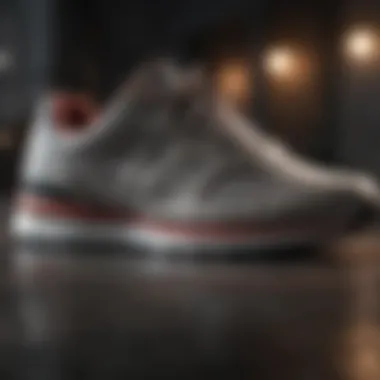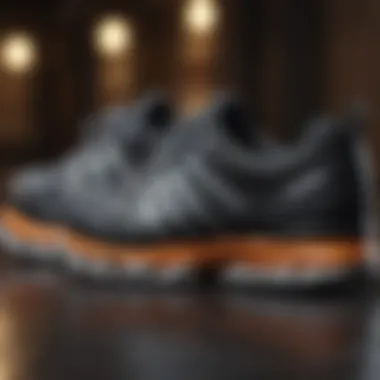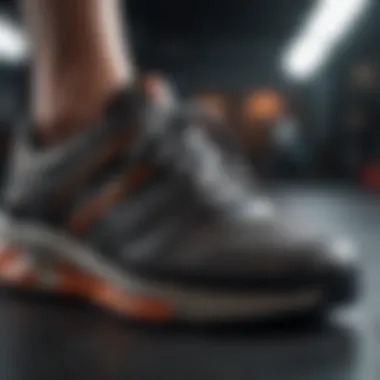Top Shoes for Personal Trainers: Essential Buying Guide


Intro
Choosing the right footwear is critical for personal trainers. The shoes worn during training can greatly affect performance, comfort, and safety. Personal trainers require shoes that not only offer support but also facilitate various movements. The demands of fitness activities vary widely, necessitating specific features in shoes.
This guide will explore the essential characteristics of the best shoes for personal trainers, focusing on factors such as stability, cushioning, flexibility, and durability. We will examine different types of shoes suitable for various training environments. In addition, we will clarify common misconceptions surrounding fitness footwear and provide actionable tips for proper shoe care.
By understanding these aspects, trainers can make informed footwear choices that enhance their performance and overall experience.
Key Takeaways
- Support and Comfort are Crucial: Good arch support and cushioning can minimize injury risks and improve endurance during workouts.
- Versatility Matters: Shoes that perform well in different training environments can save trainers from needing a full wardrobe of footwear.
- Durability Influences Longevity: Investing in high-quality shoes can lead to better performance and longer use.
- Proper Shoe Care: Routine cleaning and inspection can extend the life of the shoes, ensuring consistent performance.
In-Depth Analysis
Essential Characteristics of Footwear
In terms of performance, shoes for personal trainers should provide adequate arch support. The arch plays a vital role in weight distribution and reduces stress on feet and joints. Cushioned soles are equally important; excessive impact from jumping and movements can lead to discomfort and potential injuries. Shoes designed with foam layers or gel cushions absorb shock and enhance comfort during high-intensity training.
Flexibility is another key feature to consider. Trainers often engage in a variety of activities, from weightlifting to aerobic exercises. Shoes that allow natural foot movement can prevent restrictions that might affect performance. Look for shoes with breathable materials as well. This will keep feet dry during intense workouts, promoting overall comfort and hygiene.
Types of Shoes
There are several categories of shoes that may fit the needs of personal trainers:
- Cross-Training Shoes: Versatile and supportive, ideal for various training types.
- Minimalist Shoes: Designed to mimic barefoot training, suitable for those who prefer ground-level contact.
- Running Shoes: Best for trainers who include significant amounts of cardio in their routines.
- Weightlifting Shoes: Provide a stable base for weight training, often featuring an elevated heel for better squat form.
Misconceptions about Footwear
Many individuals believe that a higher price tag guarantees better quality. While price can reflect materials and technology, it is not always synonymous with performance. Often, trainers can find functional options in mid-range price levels without sacrificing quality. Another common misconception is that shoes must be broken in. Well-designed shoes should feel comfortable from the start; excessive breaking-in may indicate a poor fit.
Shoe Care Tips
To prolong the life of shoes, adhere to the following practices:
- Clean shoes regularly, removing dirt and debris.
- Store them in a cool, dry place to avoid deformation.
- Rotate shoes to reduce wear on a single pair.
Understanding the Importance of Appropriate Footwear
Proper footwear is critical for personal trainers. The right shoes can greatly affect performance, comfort, and injury prevention. This section delves into these key aspects to illustrate why trainers must make informed choices about their shoes.
Impact on Performance
Footwear significantly impacts athletic performance. The design of the shoe can enhance agility, endurance, and overall effectiveness during a training session. Shoes with the right grip and traction can improve stability, allowing trainers to execute movements with precision. This is particularly relevant when switching between various training activities, such as strength training and aerobics.
For example, cross-training shoes provide versatility, essential for trainers who engage in diverse workouts. Appropriate footwear can also influence energy levels. Shoes designed for running can reduce fatigue during long sessions, keeping trainers focused on their clients rather than discomfort.
Additionally, the weight of the shoe plays a role in performance. Lighter shoes can help trainers move quicker, while supportive shoes can enhance balance and core stability during exercises.
Role in Injury Prevention
Injury prevention is one of the most crucial reasons to invest in appropriate footwear. Personal trainers often put their bodies under considerable stress during workouts. Shoes lacking proper support can lead to issues like plantar fasciitis, tendonitis, and other overuse injuries. The structure of the shoe must provide adequate arch support and cushioning to absorb impact, reducing the risk of injury.


Furthermore, trainers often demonstrate exercises, increasing their risk of straining muscles or joints. Wearing shoes that do not fit well can lead to blisters, calluses, and more severe issues over time. A good fit can prevent distractions or discomfort that takes attention away from clients.
"The choice of footwear is not merely a stylistic preference; it is a fundamental aspect of effective training and injury prevention."
Ultimately, trainers should prioritize investing in quality footwear. This will create a foundation that supports their performance and well-being, enhancing their ability to serve clients effectively.
Key Features to Consider
Selecting the right shoes for personal trainers is essential for ensuring optimal performance and safety during training sessions. This section discusses vital features to consider. These elements contribute to overall effectiveness, comfort, and longevity of the shoes.
Arch Support
Arch support is a crucial feature in any training shoe. It helps maintain proper alignment of the foot while exercising. Personalized arch support can satisfy the unique needs of different foot types. A shoe that lacks adequate arch support can lead to discomfort and fatigue. It also may increase the risk of injuries such as plantar fasciitis. When looking for shoes, trainers should try options that provide sufficient arch support, especially if they have flat feet or high arches.
Cushioning and Shock Absorption
Cushioning ensures that the foot can absorb impact during various activities. Effective cushioning can reduce stress on joints and prevent injuries that arise from high-impact movements. Shoes designed for training often integrate materials such as EVA foam or gel for shock absorption. A lack of proper cushioning may result in not only sore feet but also pain in knees and hips over time. Therefore, trainers should prioritize shoes with thoughtful cushioning designs to enhance comfort throughout sessions.
Heel and Toe Drop
Heel and toe drop, which refers to the height difference between the heel and the forefoot, is another important consideration. A lower drop promotes a natural foot position and can be beneficial for activities that require agility. Conversely, a higher drop can provide stability for weightlifting or other strength training exercises. Personal trainers must assess their individual training focus and choose their footwear accordingly. Understanding this aspect can genuinely improve the functionality of their movements.
Breathability
Breathability is essential for any pair of training shoes. It allows air circulation, helping to keep the feet dry during intense workouts. Shoes made from mesh or specialized materials can enhance comfort. Ensuring breathability also helps prevent the build-up of moisture, which can cause blisters and fungal infections. Trainers should seek shoes with good ventilation to maintain optimal foot health, especially in high-temperature settings.
Weight of the Shoe
The weight of the shoe plays a significant role in overall performance. Lightweight shoes enable quick movements and agility, which are often essential in a personal training context. Conversely, heavier shoes can offer more support, but at the cost of speed. A balance should be struck based on the type of activities being performed. Personal trainers should experiment with various shoe weights to find the best option that complements their intended training style.
"The right shoe can profoundly affect performance and comfort, which directly correlates with the effectiveness of training sessions."
Types of Shoes for Personal Trainers
In the world of fitness, the right footwear plays a significant role in optimizing performance while minimizing the risk of injury. Personal trainers often work with clients in various settings, necessitating the use of different types of shoes tailored for specific activities. Understanding the unique characteristics and benefits of each type helps both trainers and their clients to make informed choices, enhancing overall training effectiveness.
Cross-Training Shoes
Cross-training shoes are designed for versatility. They offer a balance of support and flexibility, making them suitable for varied workouts that include weightlifting, aerobics, and even some running. One key feature of these shoes is their stable base, which provides support during lateral movements. This stability is essential for exercises like jumping, lunging, and side shuffles.
When selecting cross-training shoes, also consider the grip on the outsole. A good traction pattern can prevent slips during dynamic movements. These shoes usually include cushioning for comfort but are not overly cushioned to lose responsiveness. Trainers can benefit from this type of footwear, as it allows them to demonstrate multiple exercises without needing to switch shoes.
Running Shoes
Running shoes are engineered primarily for forward motion. When personal trainers work with clients primarily focused on running, the importance of proper footwear cannot be overstated. These shoes typically feature ample cushioning to absorb impact and support the arch during each stride. This not only enhances performance but also minimizes the risk of common running-related injuries.
One must pay attention to the heel-to-toe drop in running shoes, which varies by model. A lower drop can promote a more natural running style, while a higher drop may provide extra support for those with specific foot needs. The fit of the shoe is crucial; trainers should advise clients to ensure there is enough wiggle room for the toes while maintaining a snug fit around the heel.
Weightlifting Shoes
Weightlifting shoes specialize in providing stability during heavy lifts. They often feature a raised heel, which allows greater ankle mobility. This is vital for maintaining form and increasing strength during lifts like squats and deadlifts. The solid, non-compressible sole helps transfer power effectively from the foot to the ground, enhancing lifting performance.


When choosing weightlifting shoes, consider the material and construction. Many have a synthetic upper for durability and support. A good fit is essential; trainers should suggest that clients try shoes on while wearing any lifting socks they might use. This ensures the best fit and comfort during their workouts.
Court Shoes
Court shoes are built for activities such as tennis, basketball, and racquetball. They offer qualities that are vital for dynamic sports—support for quick side-to-side movement, a solid grip for various court surfaces, and cushioning to absorb impacts during jumps. The design often includes reinforced sides for lateral support.
Trainers might need to invest in court shoes if they run sessions that include agility drills or sports played on a court. It's best to select shoes with a solid midsole for added stability throughout fast-paced exercises. Personal trainers should make clients aware of the shoe's intended purpose to ensure they are correctly outfitted for specific activities.
Top Recommendations for Personal Trainers
Selecting the right shoes is not merely a matter of style for personal trainers; it is a critical aspect that directly influences performance and client outcomes. Trainers spend significant durations standing, coaching, and demonstrating exercises, which necessitates footwear that can withstand various conditions. This section highlights key recommendations for personal trainers, emphasizing different elements such as functionality, comfort, and versatility.
Best Overall Shoes
When considering the best overall shoes for personal trainers, the Nike Free Metcon stands out. This shoe seamlessly combines stability and flexibility, essential for a range of training sessions from weightlifting to high-intensity interval training. The fexible outsole allows for natural foot movement, while the firm heel provides support when lifting weights.
Another great option is the Adidas Ultraboost, which offers exceptional cushioning thanks to its Boost technology. This feature helps to absorb impact, making it an excellent choice for trainers who engage in cardio-based workouts. Its stylish look can transition from gym to casual settings easily.
Best Budget-Friendly Options
For trainers on a budget, the New Balance Fresh Foam 860 offers impressive stability and cushioning without breaking the bank. Its design prioritizes comfort, making it suitable for long hours of training.
The ASICS Gel-Venture 7 is another affordable choice, ideal for outdoor training sessions. It provides sufficient traction on various surfaces and is durable enough for extensive use. Budget-friendly shoes do not mean lower performance; both these options prove that quality can coexist with affordability.
Best High-Performance Shoes
High-performance shoes are essential for trainers looking to push their limits and lead clients effectively. The Hoka One One Bondi 7 exemplifies this category, providing maximum cushioning for long runs or intensive training sessions. This shoe caters to those needing extra heel support and is often recommended for those transitioning into long-distance running.
Alternatively, Reebok Nano X is celebrated for its versatility. It offers a balance of comfort and stability, making it excellent for various activities, including lifting, cardio, and agility workouts. Its innovative design and technology ensure peak performance regardless of the training type.
Overall, these recommendations provide personal trainers with a range of choices. Each option caters to specific needs, enabling trainers to select footwear that enhances their performance and supports their profession.
Common Misconceptions About Shoe Selection
Misconceptions surrounding footwear for personal trainers can lead to poor choices, impacting performance and health. Understanding these pitfalls is vital for trainers and fitness enthusiasts alike. This section aims to clarify misunderstandings about shoe selection, helping individuals make better decisions.
All Sneakers are Suitable for Training
A prevalent misconception is that any sneaker can effectively serve as a training shoe. In reality, different types of sneakers excel in specific environments. For instance, running shoes are designed to provide support primarily during forward motion, while cross-training shoes offer versatility in lateral movements and varied workouts.
Using inappropriate footwear can lead to discomfort and even injuries. It is important to consider activities performed during training. Shoes should offer the right kind of support and stability for the particular exercises being done.
- Running shoes are best suited for activities focused on running and jogging. They provide good cushioning but lack lateral support.
- Cross-trainers are designed for a variety of activities. They offer more stability across different movements.
- Weightlifting shoes are specialized with a raised heel to aid in proper form during lifts.
Selecting the wrong shoe can lead to excessive wear or even chronic pain over time. This understanding underscores the necessity of defining the activity type before choosing footwear. Trainers should emphasize the importance of selecting shoes specifically tailored for the intended activities.
Price Equals Quality
Another misconception is that a higher price tag guarantees superior quality. While this is often true, it is not universally applicable. Price does not always reflect performance or durability. Many affordable options provide adequate support, cushioning, and comfort.
It's essential to evaluate shoes based on specifications rather than price. Considerations should include:


- Fit and comfort
- Material quality
- The reputation of the brand based on performance reviews
Investing wisely means searching for shoes that combine quality and affordability. It's possible to find reasonably priced options that meet the necessary performance standards for trainers.
"Quality doesn’t always come at a higher price point; it comes from understanding your needs and selecting shoes that match them."
A critical assessment of what constitutes value is vital. Sometimes, paying extra does not equate to overall better performance. The crucial factor is fitting the shoe to one's specific training requirements. This approach ensures that personal trainers can optimize their footwear choices for long-term effectiveness.
Maintenance and Care for Training Shoes
Proper maintenance and care of training shoes is crucial for those engaged in fitness and personal training. Just as one would invest in maintaining equipment, so too should one care for footwear. Shoes undergo significant wear and tear from diverse workouts. This affects their performance and suitability over time.
Caring for training shoes extends their lifespan, ensuring optimal performance while reducing the risk of injury. Well-maintained shoes provide consistent support and cushioning, which are essential for high-impact activities. This section delves into effective cleaning techniques and storage recommendations for your training shoes.
Cleaning Techniques
Keeping training shoes clean is fundamental. Dirt, sweat, and other substances can degrade materials and affect comfort. Here are some effective cleaning techniques:
- Regular Inspection: Frequently check shoes for signs of dirt. This also helps to spot deteriorating materials.
- Use a Soft Brush: A soft-bristled brush can remove dirt. Focus on the sole and upper parts.
- Mild Soap Solution: Consider using warm water mixed with a bit of mild soap. Dip a cloth in this solution and gently clean the shoes. Rinse with clean water to prevent residue.
- Avoid Machine Wash: Machine washing can distort the shoe's shape. Stick to hand-cleaning where possible.
- Drying: After cleaning, allow shoes to air dry at room temperature. Avoid direct sunlight or heat sources as they can damage materials.
Storage Recommendations
Proper storage of training shoes can further enhance their longevity. Here are some recommended practices for storing your footwear:
- Keep in a Cool, Dry Place: Store shoes in well-ventilated areas away from extreme temperatures.
- Use Original Boxes: If possible, keep shoes in their original boxes. This protects them from dust and deforming.
- Avoid Compression: Do not stack heavy items on top of shoes. This helps maintain their shape and structure.
- Remove Insoles: Taking out insoles can prevent odor and moisture buildup. Ensure they are dry before placing them back.
- Regular Rotation: If you have several pairs of training shoes, rotate them to evenly distribute wear.
The Role of Fit in Shoe Selection
Selecting the right shoes goes beyond just style or brand. Proper fit is critical in ensuring optimal performance for personal trainers. When footwear is well-fitted, it provides the necessary support, reduces the risk of injury, and enhances overall comfort during workouts. Every individual's foot structure is unique, and thus, understanding fit is essential in making an informed choice.
Importance of Proper Fit
A proper fit serves multiple purposes. First, it helps in maintaining alignment during exercise, which reduces the risk of strains or other injuries. Shoes that do not fit right can create areas of pressure, leading to discomfort.
Moreover, the right fit allows better blood circulation in the foot. When shoes are too tight, they can restrict blood flow, resulting in numbness or cramping. Conversely, shoes that are too loose can cause instability, making it difficult for personal trainers to perform exercises safely.
Here are some specific benefits of having a proper fit:
- Enhanced Performance: Trainers can move more naturally without restriction.
- Injury Prevention: A well-fitting shoe reduces the chances of blisters, calluses, and other foot ailments.
- Increased Comfort: Trainers can focus entirely on their workouts rather than on their feet.
"The right fit empowers trainers to guide their clients effectively, as discomfort can distract from training objectives."
How to Measure Foot Size Accurately
Measuring foot size accurately is a vital step in finding the right fit. Here are practical steps to help in this process:
- Stand during measurement: Always measure feet while standing, as this allows for the natural expansion of the foot.
- Use a Brannock Device: This tool can measure both the length and width of the foot. It is often available at shoe stores.
- Measure both feet: Feet can differ in size. It's crucial to measure both feet and choose shoes based on the larger one.
- Check size towards the end of the day: Feet can swell during the day, so measuring in the evening might give a better indication of the usual size.
- Remember Width: Don't overlook the width, as both length and width impact comfort and fit.
Culmination
The conclusion serves as a critical reflection of the entire discourse on appropriate footwear for personal trainers. This section crystallizes the insights provided throughout the article, reinforcing the necessity of suitable shoes in enhancing performance and minimizing the risk of injuries during training. Personal trainers operate in a unique environment that often demands versatility in shoe capabilities. Therefore, one essential consideration is the shoe's adaptability to various training scenarios that they may encounter. A well-selected shoe acts as an enabler, supporting the trainer in accomplishing their multifaceted roles effectively.
Recap of Key Points
In revisiting the pivotal elements tied to choosing the best shoes for personal trainers, several clear points emerge:
- Impact on Performance: Appropriate footwear can enhance movement efficiency, contributing to better client training outcomes.
- Injury Prevention: Proper support and cushioning significantly lower injury risks, safeguarding both the trainer and their clients.
- Key Features: Focus on features such as arch support, cushioning, heel drop, breathability, and overall shoe weight to ensure optimal performance.
- Types of Shoes: Recognize the different shoe types available, including cross-training, running, and weightlifting shoes, each catering to specific needs.
- Common Misconceptions: Awareness of misbeliefs surrounding footwear selection can guide trainers towards making more informed decisions.
- Maintenance: Regular care emphasizes shoe longevity, establishing a reliable training experience over time.
- Fit Importance: Ensuring a snug yet comfortable fit should be a priority to improve overall training effectiveness and comfort.
Final Thoughts
In summary, selecting the right footwear is not just a matter of personal preference; it is a fundamental component of a trainer's toolkit that influences all aspects of their profession. The correct shoes can lead to enhanced stability and comfort, ultimately translating to superior workout efficiency. Personal trainers must undergo thoughtful deliberation when choosing their footwear. This guide is intended to empower personal trainers to make choices grounded in knowledge and practicality, ensuring that both the trainers and their clients traverse their fitness journeys with optimal efficiency. The synthesis of information throughout the article emphasizes the multifaceted necessity of proper footwear. As the fitness landscape evolves, so too should our understanding and approach to training footwear.







